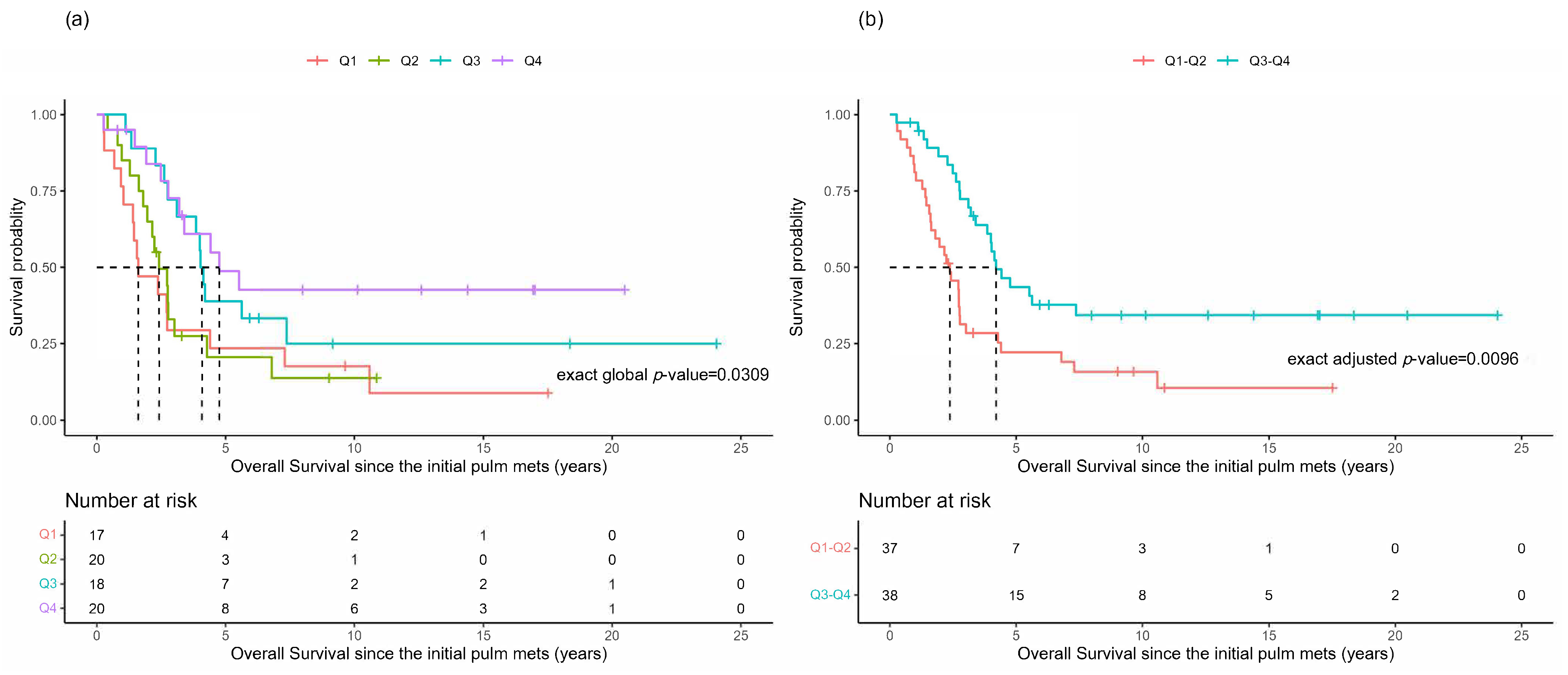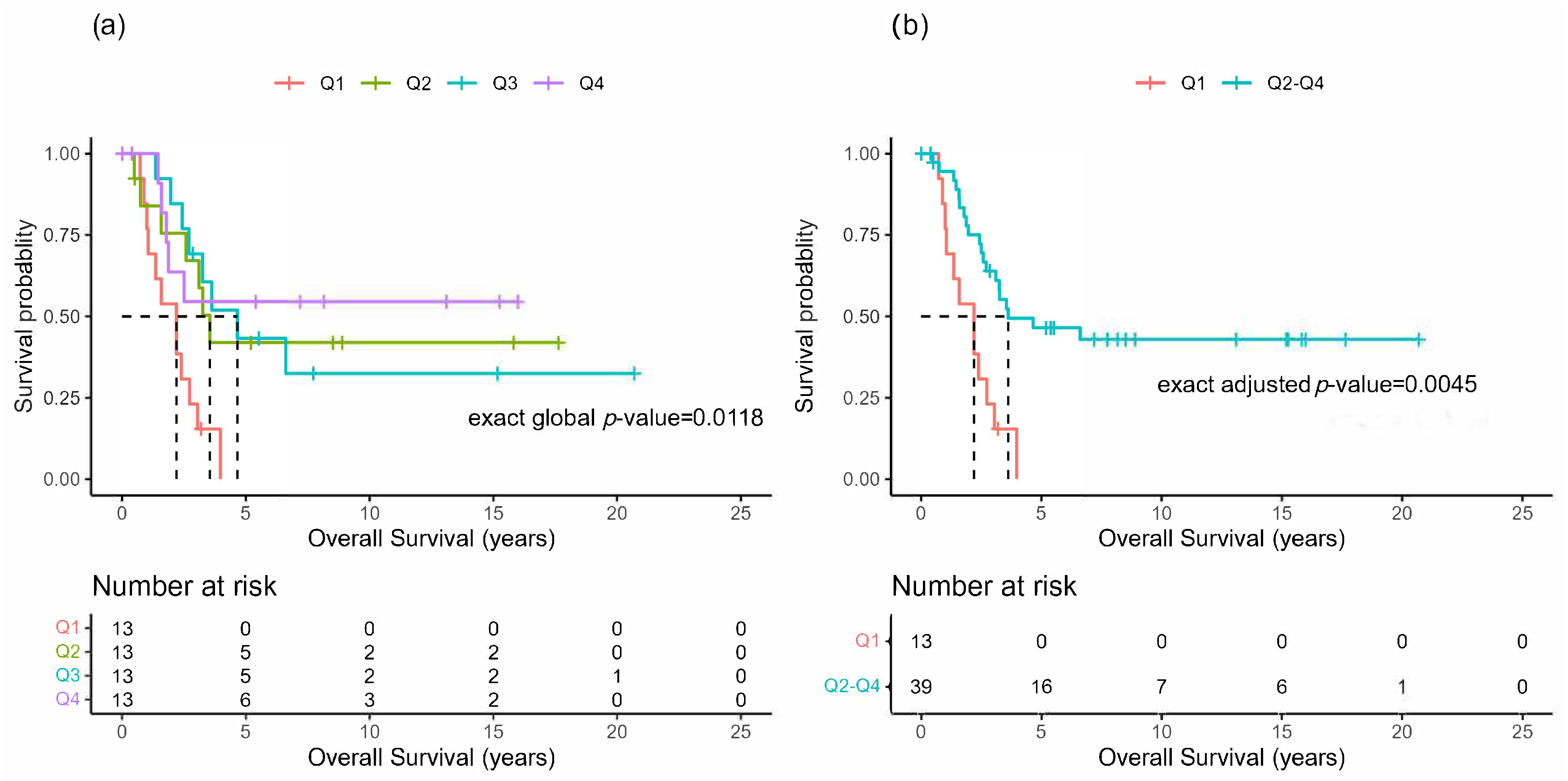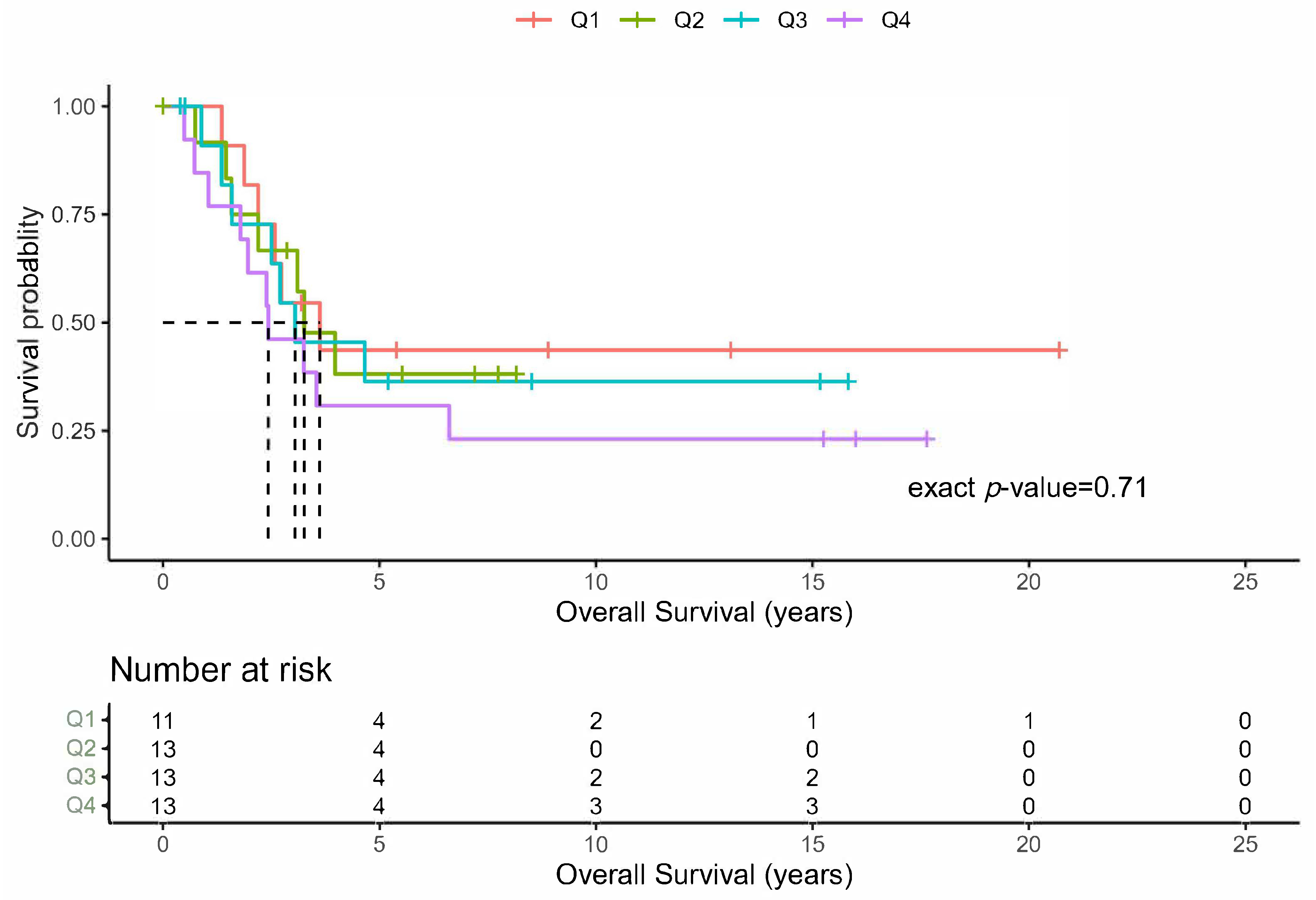Pulmonary Metastasectomy for Adrenocortical Carcinoma—Not If, but When †
Abstract
Simple Summary
Abstract
1. Introduction
2. Methods
2.1. Data Collection
2.2. Statistical Analysis
3. Results
3.1. All Patients
3.2. Patients Undergoing PM
4. Comment
5. Conclusions
Supplementary Materials
Author Contributions
Funding
Institutional Review Board Statement
Informed Consent Statement
Data Availability Statement
Conflicts of Interest
Abbreviations
| ACC | adrenocortical carcinoma |
| CI | confidence interval |
| CRC | colorectal carcinoma |
| DFI | disease-free interval |
| DFS | disease-free survival |
| HR | hazard ratio |
| K-M | Kaplan-Meier |
| LM | lung metastases |
| NCI | National Cancer Institute |
| NIDDK | National Institutes of Diabetes and Digestive and Kidney Disease |
| OS | overall survival |
| PFS | progression-free survival |
| PM | pulmonary metastasectomy |
| Q1 | first quartile |
| Q2 | second quartile |
| Q3 | third quartile |
| Q4 | fourth quartile |
| VATS | video-assisted thoracoscopic surgery |
References
- Aberg, T.; Malmberg, K.A.; Nilsson, B.; Nöu, E. The Effect of Metastasectomy: Fact or Fiction? Ann. Thorac. Surg. 1980, 30, 378–384. [Google Scholar] [CrossRef]
- Erhunmwunsee, L.; D’Amico, T.A. Surgical Management of Pulmonary Metastases. Ann. Thorac. Surg. 2009, 88, 2052–2060. [Google Scholar] [CrossRef] [PubMed]
- Pastorino, U.; Buyse, M.; Friedel, G.; Ginsberg, R.J.; Girard, P.; Goldstraw, P.; Johnston, M.; McCormack, P.; Pass, H.; Putnam, J.B. Long-Term Results of Lung Metastasectomy: Prognostic Analyses Based on 5206 Cases. J. Thorac. Cardiovasc. Surg. 1997, 113, 37–49. [Google Scholar] [CrossRef]
- Migliore, M.; Jakovic, R.; Hensens, A.; Klepetko, W. Extending Surgery for Pulmonary Metastasectomy: What Are the Limits? J. Thorac. Oncol. 2010, 5 (Suppl. S2), S155–S160. [Google Scholar] [CrossRef] [PubMed]
- Onaitis, M.W.; Petersen, R.P.; Haney, J.C.; Saltz, L.; Park, B.; Flores, R.; Rizk, N.; Bains, M.S.; Dycoco, J.; D’Amico, T.A.; et al. Prognostic Factors for Recurrence after Pulmonary Resection of Colorectal Cancer Metastases. Ann. Thorac. Surg. 2009, 87, 1684–1688. [Google Scholar] [CrossRef]
- Treasure, T.; Farewell, V.; Macbeth, F.; Batchelor, T.; Milošević, M.; King, J.; Zheng, Y.; Leonard, P.; Williams, N.R.; Brew-Graves, C.; et al. The Pulmonary Metastasectomy in Colorectal Cancer Cohort Study: Analysis of Case Selection, Risk Factors and Survival in a Prospective Observational Study of 512 Patients. Color. Dis. 2021, 23, 1793–1803. [Google Scholar] [CrossRef] [PubMed]
- Milosevic, M.; Edwards, J.; Tsang, D.; Dunning, J.; Shackcloth, M.; Batchelor, T.; Coonar, A.; Hasan, J.; Davidson, B.; Marchbank, A.; et al. Pulmonary Metastasectomy in Colorectal Cancer: Updated Analysis of 93 Randomized Patients—Control Survival Is Much Better than Previously Assumed. Color. Dis. 2020, 22, 1314–1324. [Google Scholar] [CrossRef]
- Terzolo, M.; Berruti, A. Adjunctive Treatment of Adrenocortical Carcinoma. Curr. Opin. Endocrinol. Diabetes Obes. 2008, 15, 221–226. [Google Scholar] [CrossRef]
- Glenn, J.A.; Else, T.; Hughes, D.T.; Cohen, M.S.; Jolly, S.; Giordano, T.J.; Worden, F.P.; Gauger, P.G.; Hammer, G.D.; Miller, B.S. Longitudinal Patterns of Recurrence in Patients with Adrenocortical Carcinoma. Surgery 2019, 165, 186–195. [Google Scholar] [CrossRef]
- Kimpel, O.; Bedrose, S.; Megerle, F.; Berruti, A.; Terzolo, M.; Kroiss, M.; Mai, K.; Dekkers, O.M.; Habra, M.A.; Fassnacht, M. Adjuvant Platinum-Based Chemotherapy in Radically Resected Adrenocortical Carcinoma: A Cohort Study. Br. J. Cancer 2021, 125, 1233–1238. [Google Scholar] [CrossRef]
- Megerle, F.; Kroiss, M.; Hahner, S.; Fassnacht, M. Advanced Adrenocortical Carcinoma—What to Do When First-Line Therapy Fails? Exp. Clin. Endocr. Diab. 2018, 127, 109–116. [Google Scholar] [CrossRef]
- Megerle, F.; Herrmann, W.; Schloetelburg, W.; Ronchi, C.L.; Pulzer, A.; Quinkler, M.; Beuschlein, F.; Hahner, S.; Kroiss, M.; Fassnacht, M.; et al. Mitotane Monotherapy in Patients with Advanced Adrenocortical Carcinoma. J. Clin. Endocrinol. Metab. 2017, 103, 1686–1695. [Google Scholar] [CrossRef]
- Fassnacht, M.; Terzolo, M.; Allolio, B.; Baudin, E.; Haak, H.; Berruti, A.; Welin, S.; Schade-Brittinger, C.; Lacroix, A.; Jarzab, B.; et al. Combination Chemotherapy in Advanced Adrenocortical Carcinoma. N. Engl. J. Med. 2012, 366, 2189–2197. [Google Scholar] [CrossRef] [PubMed]
- Quiros, R.M.; Scott, W.J. Surgical Treatment of Metastatic Disease to the Lung. Semin. Oncol. 2008, 35, 134–146. [Google Scholar] [CrossRef]
- Icard, P.; Goudet, P.; Charpenay, C.; Andreassian, B.; Carnaille, B.; Chapuis, Y.; Cougard, P.; Henry, J.-F.; Proye, C. Adrenocortical Carcinomas: Surgical Trends and Results of a 253-Patient Series from the French Association of Endocrine Surgeons Study Group. World J. Surg. 2001, 25, 891–897. [Google Scholar] [CrossRef] [PubMed]
- Kemp, C.D.; Ripley, R.T.; Mathur, A.; Steinberg, S.M.; Nguyen, D.M.; Fojo, T.; Schrump, D.S. Pulmonary Resection for Metastatic Adrenocortical Carcinoma: The National Cancer Institute Experience. Ann. Thorac. Surg. 2011, 92, 1195–1200. [Google Scholar] [CrossRef] [PubMed]
- Datrice, N.M.; Langan, R.C.; Ripley, R.T.; Kemp, C.D.; Steinberg, S.M.; Wood, B.J.; Libutti, S.K.; Fojo, T.; Schrump, D.S.; Avital, I. Operative Management for Recurrent and Metastatic Adrenocortical Carcinoma. J. Surg. Oncol. 2012, 105, 709–713. [Google Scholar] [CrossRef] [PubMed]
- Schulick, R.D.; Brennan, M.F. Long-Term Survival after Complete Resection and Repeat Resection in Patients with Adrenocortical Carcinoma. Ann. Surg. Oncol. 1999, 6, 719–726. [Google Scholar] [CrossRef] [PubMed]
- Jensen, J.C.; Pass, H.I.; Sindelar, W.F.; Norton, J.A. Recurrent or Metastatic Disease in Select Patients with Adrenocortical Carcinoma: Aggressive Resection vs Chemotherapy. Arch. Surg. 1991, 126, 457–461. [Google Scholar] [CrossRef]
- Grubbs, E.G.; Callender, G.G.; Xing, Y.; Perrier, N.D.; Evans, D.B.; Phan, A.T.; Lee, J.E. Recurrence of Adrenal Cortical Carcinoma Following Resection: Surgery Alone Can Achieve Results Equal to Surgery Plus Mitotane. Ann. Surg. Oncol. 2010, 17, 263–270. [Google Scholar] [CrossRef]
- op den Winkel, J.; Pfannschmidt, J.; Muley, T.; Grünewald, C.; Dienemann, H.; Fassnacht, M.; Allolio, B. Metastatic Adrenocortical Carcinoma: Results of 56 Pulmonary Metastasectomies in 24 Patients. Ann. Thorac. Surg. 2011, 92, 1965–1970. [Google Scholar] [CrossRef]
- Cooper, J.D.; Perelman, M.; Todd, T.R.; Ginsberg, R.J.; Patterson, G.A.; Pearson, F.G. Precision Cautery Excision of Pulmonary Lesions. Ann. Thorac. Surg. 1986, 41, 51–53. [Google Scholar] [CrossRef]
- Schulick, R.D.; Brennan, M.F. Adrenocortical Carcinoma. World J. Urol. 1999, 17, 26–34. [Google Scholar] [CrossRef]
- Owen, D.H.; Patel, S.; Wei, L.; Phay, J.E.; Shirley, L.A.; Kirschner, L.S.; Schmidt, C.; Abdel-Misih, S.; Brock, P.; Shah, M.H.; et al. Metastatic Adrenocortical Carcinoma: A Single Institutional Experience. Hormones Cancer 2019, 10, 161–167. [Google Scholar] [CrossRef] [PubMed]
- Haak, H.; Hermans, J.; van de Velde, C.; Lentjes, E.; Goslings, B.; Fleuren, G.-J.; Krans, H. Optimal Treatment of Adrenocortical Carcinoma with Mitotane: Results in a Consecutive Series of 96 Patients. Br. J. Cancer 1994, 69, 947–951. [Google Scholar] [CrossRef] [PubMed]
- Dy, B.M.; Strajina, V.; Cayo, A.K.; Richards, M.L.; Farley, D.R.; Grant, C.S.; Harmsen, W.S.; Evans, D.B.; Grubbs, E.G.; Bible, K.C.; et al. Surgical Resection of Synchronously Metastatic Adrenocortical Cancer. Ann. Surg. Oncol. 2015, 22, 146–151. [Google Scholar] [CrossRef] [PubMed]
- Smith, R.; Pak, Y.; Kraybill, W.; Kane, J.M. Factors Associated with Actual Long-Term Survival Following Soft Tissue Sarcoma Pulmonary Metastasectomy. Eur. J. Surg. Oncol. 2009, 35, 356–361. [Google Scholar] [CrossRef] [PubMed]
- Younes, R.N.; Fares, A.L.; Gross, J.L. Pulmonary Metastasectomy: A Multivariate Analysis of 440 Patients Undergoing Complete Resection. Interact. Cardiovasc. Thorac. Surg. 2012, 14, 156–161. [Google Scholar] [CrossRef] [PubMed]



| Variable | No. (%) |
|---|---|
| Feature: | |
| Sex, M/F | 16/59 |
| Age at primary adrenalectomy, non-PM group, median, years (range) | 50 (27–59) |
| Age at primary adrenalectomy, PM group, median, years (range) | 41 (9–68) |
| Age at first PM, median, years (range) | 45 (9–72) |
| Number of lung metastases, median (range) | 8 (1–75) |
| Pulmonary Metastasectomy: | |
| Yes | 52 (69) |
| 1–2 PMs | 33 (63) |
| 3–5 PMs | 16 (31) |
| 5–7 PMs | 3 (6) |
| No | 23 (31) |
| Hormonal Status at Presentation: | |
| Functional | 41 (55) |
| Hypercortisolism | 26 (63) |
| Hyperaldosteronism | 8 (20) |
| Virilization | 5 (12) |
| Feminization | 2 (5) |
| Nonfunctional | 31 (41) |
| Unknown | 3 (4) |
| Systemic Therapy: | |
| Yes | 71 (95) |
| No | 4 (5) |
| Systemic Therapy PM Group: | |
| Induction Chemotherapy | 5 (10) |
| Adjuvant Chemotherapy | 46 (88) |
| Systemic Therapy Non-PM Group: | |
| Yes | 23 (100) |
| Median (95% CI) | p-Value a | |||||||
|---|---|---|---|---|---|---|---|---|
| Q1 | Q2 | Q3 | Q4 | Q1–Q2 | Q3–Q4 | Global b | As Grouped c | |
| OS (years) | 1.6 (0.9, 4.4) | 2.4 (1.6, 3.0) | 4.1 (2.8, 7.4) | 4.8 (2.8, -) | 2.4 (1.6, 2.8) | 4.2 (3.2, -) | 0.031 | 0.0096 (0.0032) |
| Quartiles Subgroups | N a | b | c | HR d | p-Value e |
|---|---|---|---|---|---|
| Q1 | 17 | 7 | 10 | 0.50 | 0.2827 |
| Q2 | 20 | 13 | 7 | 1.36 | 0.5588 |
| Q3 | 18 | 16 | 2 | 1.33 | 0.7287 |
| Q4 | 20 | 16 | 4 | 0.99 | 0.9838 |
| Q1–Q2 | 37 | 20 | 17 | 0.90 | 0.7899 |
| Q3–Q4 | 38 | 32 | 6 | 1.20 | 0.7212 |
| Outcome | Median (95% CI) | Survival Probability (95% CI) | |
|---|---|---|---|
| OS | 5 years | 10 years | |
| 3.1 years (2.4, 4.7) | 35.5% (22.3%, 49.0%) | 32.8% (19.8%, 46.4%) | |
| DFS | 1 year | 2 years | |
| 1.5 years (0.7, 2.2) | 57.1% (33.8%, 74.9%) | 33.3% (14.9%, 53.1%) | |
| PFS | 6 months | 12 months | |
| 3.0 months (1.9, 9.9) | 39.7% (22.5%, 56.5%) | 27.8% (12.9%, 44.9%) | |
Disclaimer/Publisher’s Note: The statements, opinions and data contained in all publications are solely those of the individual author(s) and contributor(s) and not of MDPI and/or the editor(s). MDPI and/or the editor(s) disclaim responsibility for any injury to people or property resulting from any ideas, methods, instructions or products referred to in the content. |
© 2024 by the authors. Licensee MDPI, Basel, Switzerland. This article is an open access article distributed under the terms and conditions of the Creative Commons Attribution (CC BY) license (https://creativecommons.org/licenses/by/4.0/).
Share and Cite
Carr, S.R.; Villa Hernandez, F.; Varghese, D.G.; Choo-Wosoba, H.; Steinberg, S.M.; Teke, M.E.; Del Rivero, J.; Schrump, D.S.; Hoang, C.D. Pulmonary Metastasectomy for Adrenocortical Carcinoma—Not If, but When. Cancers 2024, 16, 702. https://doi.org/10.3390/cancers16040702
Carr SR, Villa Hernandez F, Varghese DG, Choo-Wosoba H, Steinberg SM, Teke ME, Del Rivero J, Schrump DS, Hoang CD. Pulmonary Metastasectomy for Adrenocortical Carcinoma—Not If, but When. Cancers. 2024; 16(4):702. https://doi.org/10.3390/cancers16040702
Chicago/Turabian StyleCarr, Shamus R., Frank Villa Hernandez, Diana Grace Varghese, Hyoyoung Choo-Wosoba, Seth M. Steinberg, Martha E. Teke, Jaydira Del Rivero, David S. Schrump, and Chuong D. Hoang. 2024. "Pulmonary Metastasectomy for Adrenocortical Carcinoma—Not If, but When" Cancers 16, no. 4: 702. https://doi.org/10.3390/cancers16040702
APA StyleCarr, S. R., Villa Hernandez, F., Varghese, D. G., Choo-Wosoba, H., Steinberg, S. M., Teke, M. E., Del Rivero, J., Schrump, D. S., & Hoang, C. D. (2024). Pulmonary Metastasectomy for Adrenocortical Carcinoma—Not If, but When. Cancers, 16(4), 702. https://doi.org/10.3390/cancers16040702







